What is a metal print? A metal print is a unique and modern form of photography that combines the vibrancy of traditional prints with the durability and longevity of metal. Unlike traditional photo prints, which are susceptible to fading and damage, metal prints are highly resistant to scratches, water, and UV rays, making them an ideal choice for both indoor and outdoor display.
Metal prints are created by infusing dye directly onto a specially coated aluminum surface using a high-heat sublimation process. This process results in a vibrant and detailed image that is embedded within the metal, ensuring exceptional color accuracy and longevity.
The resulting print is lightweight, durable, and waterproof, making it suitable for a wide range of applications, from fine art displays to commercial signage.
Metal Print Definition
A metal print is a photographic print made by infusing dye directly into a specially coated aluminum surface. This process creates a vibrant, durable, and waterproof print that is resistant to fading and scratching.
Unlike traditional photo prints, which are printed on paper and then mounted on a backing, metal prints are made in one piece. This makes them lighter and more durable than traditional prints, and they can be hung without the need for a frame.
Advantages of Metal Prints
- Vibrant colors and high contrast
- Durable and waterproof
- Lightweight and easy to hang
- Resistant to fading and scratching
Metal Print Materials
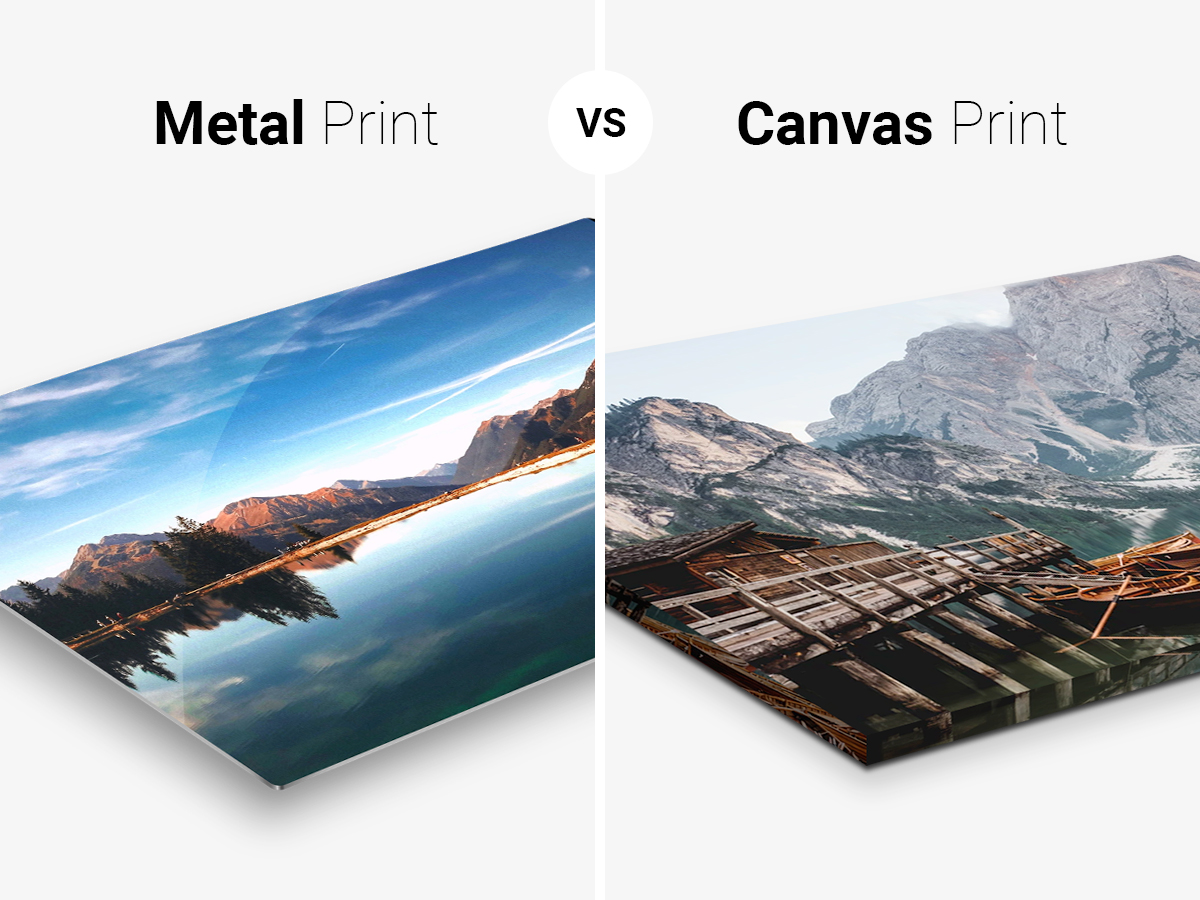
Metal prints are created using various types of metals, each with its own unique properties and advantages. The choice of metal can impact the overall look, durability, and cost of the print.
The most common metals used in metal prints include:
- Aluminum
- Stainless steel
- Brass
- Copper
Aluminum
Aluminum is a lightweight and durable metal that is commonly used in metal prints. It is resistant to corrosion and fading, making it a good choice for outdoor applications or areas with high humidity. Aluminum prints are also relatively inexpensive, making them a cost-effective option.
Stainless Steel
Stainless steel is a strong and corrosion-resistant metal that is often used in metal prints for its durability and longevity. It is more expensive than aluminum, but it can withstand harsh conditions and is less likely to scratch or dent.
Stainless steel prints are a good choice for high-traffic areas or applications where durability is important.
Brass
Brass is a copper alloy that is known for its warm, golden color. It is a durable metal that is resistant to corrosion, making it a good choice for both indoor and outdoor applications. Brass prints have a classic and elegant look that can complement a variety of décor styles.
Copper
Copper is a reddish-brown metal that is known for its natural patina. It is a soft metal that is easily scratched, but it can be coated with a protective layer to improve its durability. Copper prints have a unique and rustic look that can add character to any space.
Explain the various types of metal used in metal print production.

Various metals are used in metal print production, each with its unique characteristics and advantages. The most commonly used metals include aluminum, stainless steel, and copper.
Aluminum
Aluminum is a lightweight and durable metal that is resistant to corrosion. It is also relatively inexpensive, making it a popular choice for metal prints. Aluminum prints have a bright white finish that can be printed with vibrant colors.
Stainless steel
Stainless steel is a strong and durable metal that is resistant to corrosion and scratches. It has a silver finish that can be printed with a wide range of colors. Stainless steel prints are more expensive than aluminum prints, but they are also more durable.
Copper
Copper is a reddish-brown metal that is resistant to corrosion. It has a warm, antique finish that can be printed with a variety of colors. Copper prints are more expensive than aluminum and stainless steel prints, but they offer a unique and elegant look.
Metal Print Finishes
The finish of a metal print plays a crucial role in determining its aesthetic appeal, durability, and maintenance requirements. Different finishes offer unique effects and benefits, allowing you to customize your metal print to complement your desired style and functional needs.
Glossy Finish
- Imparts a mirror-like sheen, enhancing color vibrancy and creating a high-impact visual experience.
- Suitable for images with bold colors, sharp details, and high contrast, such as landscapes, cityscapes, and abstract art.
- Requires careful handling and cleaning to avoid scratches and fingerprints.
Matte Finish
- Provides a subtle, non-reflective surface, reducing glare and creating a more understated look.
- Ideal for images with softer colors, delicate textures, and vintage or retro aesthetics.
- More durable and easier to clean than glossy finishes, making it suitable for high-traffic areas.
Satin Finish
- Offers a balance between glossy and matte finishes, providing a slight sheen while minimizing glare.
- Versatile finish suitable for a wide range of images, including portraits, nature scenes, and architectural photography.
- Moderately durable and requires occasional cleaning to maintain its appearance.
Textured Finish
- Creates a unique tactile experience with raised or embossed patterns on the metal surface.
- Adds depth and dimension to images, making them more engaging and visually appealing.
- Suitable for artistic prints, abstract designs, and images with intricate details.
Brushed Finish
- Features fine, parallel lines etched into the metal surface, creating a subtle, brushed texture.
- Adds a modern and industrial aesthetic to images, particularly those with metallic or geometric elements.
- Durable and easy to clean, making it a practical choice for both indoor and outdoor applications.
| Finish | Effect | Benefits | Durability | Maintenance |
|---|---|---|---|---|
| Glossy | Mirror-like sheen | Vibrant colors, sharp details | Low | Requires careful handling |
| Matte | Subtle, non-reflective | Soft colors, vintage aesthetics | High | Easy to clean |
| Satin | Balanced sheen | Versatile, minimizes glare | Moderate | Occasional cleaning |
| Textured | Raised patterns | Depth, dimension | Varies | Depends on texture |
| Brushed | Fine, parallel lines | Modern, industrial aesthetic | High | Easy to clean |
Choosing the Right Finish
Selecting the right finish for your metal print depends on your desired aesthetic, functional requirements, and the specific image you’re printing. Consider the following factors:
- Image Type:Different finishes complement different image styles. Glossy finishes enhance bold colors and sharp details, while matte finishes soften softer colors and textures.
- Durability:Matte and brushed finishes are more durable and easier to maintain, making them suitable for high-traffic areas or outdoor applications.
- Personal Preference:Ultimately, the best finish is the one that aligns with your personal taste and the intended use of the metal print.
Metal Print Applications
Metal prints are gaining popularity in various industries due to their durability, versatility, and aesthetic appeal. They are widely used in art, photography, and interior design, among other applications.
In the art world, metal prints are prized for their ability to showcase vibrant colors and sharp details. They are often used for fine art reproductions, photography, and abstract paintings. Metal prints can enhance the visual impact of artworks, making them appear more modern and sophisticated.
Photography
Metal prints are highly valued in the photography industry. They provide a unique and striking way to display photographs, bringing out the richness and depth of the images. Metal prints are particularly suitable for landscape, architectural, and wildlife photography, where the sharp details and vivid colors can truly shine.
Interior Design
Metal prints are increasingly popular in interior design. They add a touch of modernity and elegance to any space. Metal prints can be used as wall art, kitchen backsplashes, and even furniture accents. Their durability makes them suitable for high-traffic areas, and their versatility allows them to complement various design styles, from industrial to contemporary.
Metal Print Advantages
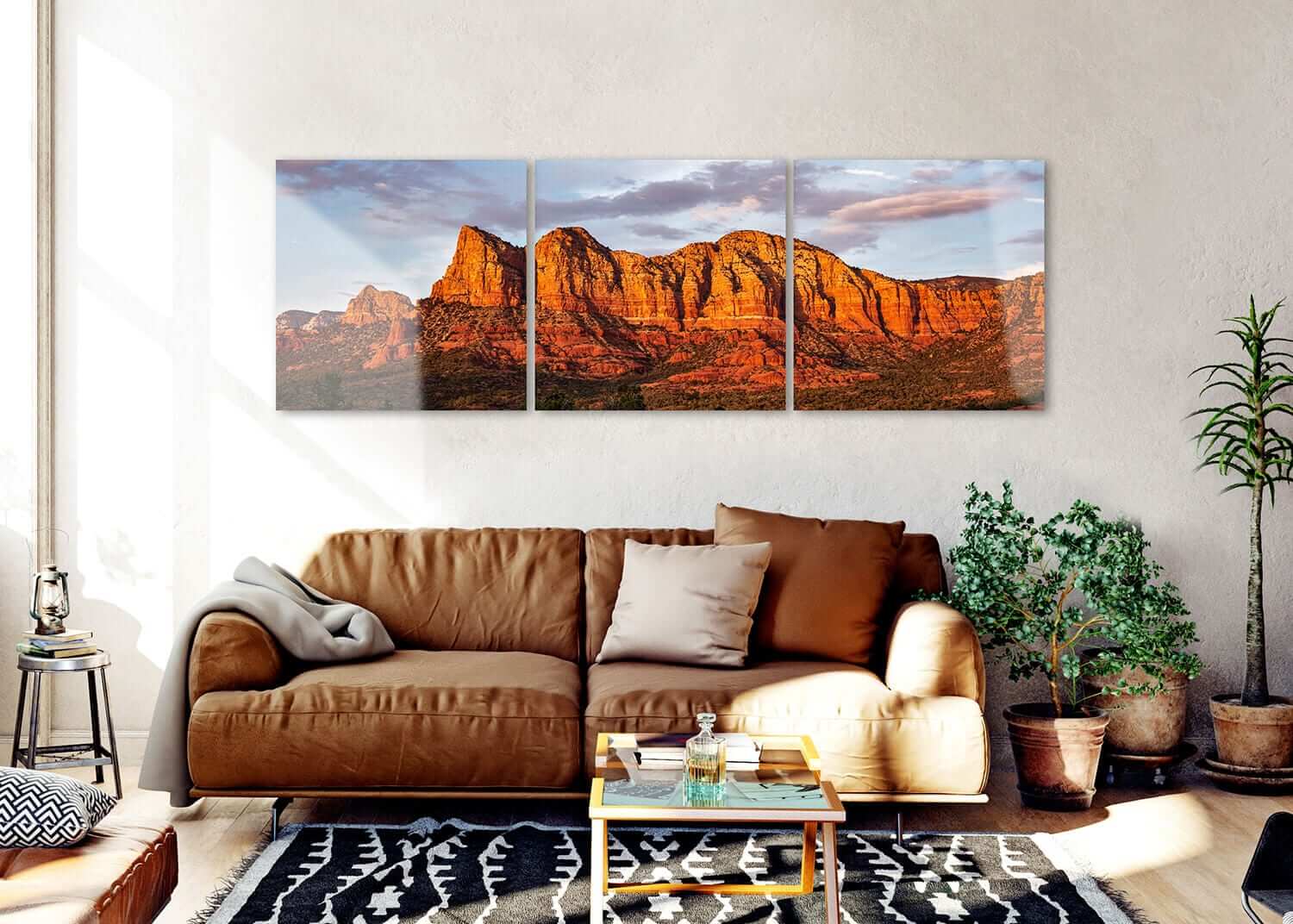
Metal prints offer numerous advantages over traditional photo prints, making them a popular choice for both personal and professional photography display.
Metal prints are renowned for their exceptional durability and longevity. Unlike traditional photo prints that can fade or deteriorate over time, metal prints are resistant to moisture, UV rays, and scratches, ensuring that your precious memories remain vibrant and pristine for decades to come.
Aesthetic Appeal
Metal prints possess a unique and captivating aesthetic appeal that sets them apart from traditional photo prints. The smooth, reflective surface of metal creates a luminous effect that enhances the depth and richness of colors, resulting in stunning and eye-catching displays.
Metal prints are particularly well-suited for displaying landscapes, where the vibrant colors and intricate details of nature are brought to life. They also add a touch of sophistication and modernity to portraits, capturing the emotions and expressions of your subjects with remarkable clarity.
Value Proposition
While metal prints may have a slightly higher upfront cost compared to traditional photo prints, their exceptional durability and aesthetic appeal make them a worthwhile investment. Metal prints retain their beauty and vibrancy for a lifetime, eliminating the need for costly reprints or replacements.
The value proposition of metal prints is particularly evident in the context of professional photography, where the preservation of high-quality images is crucial. Metal prints ensure that your work remains pristine and visually stunning for years to come, showcasing your artistry and preserving the integrity of your creations.
Metal Print Disadvantages
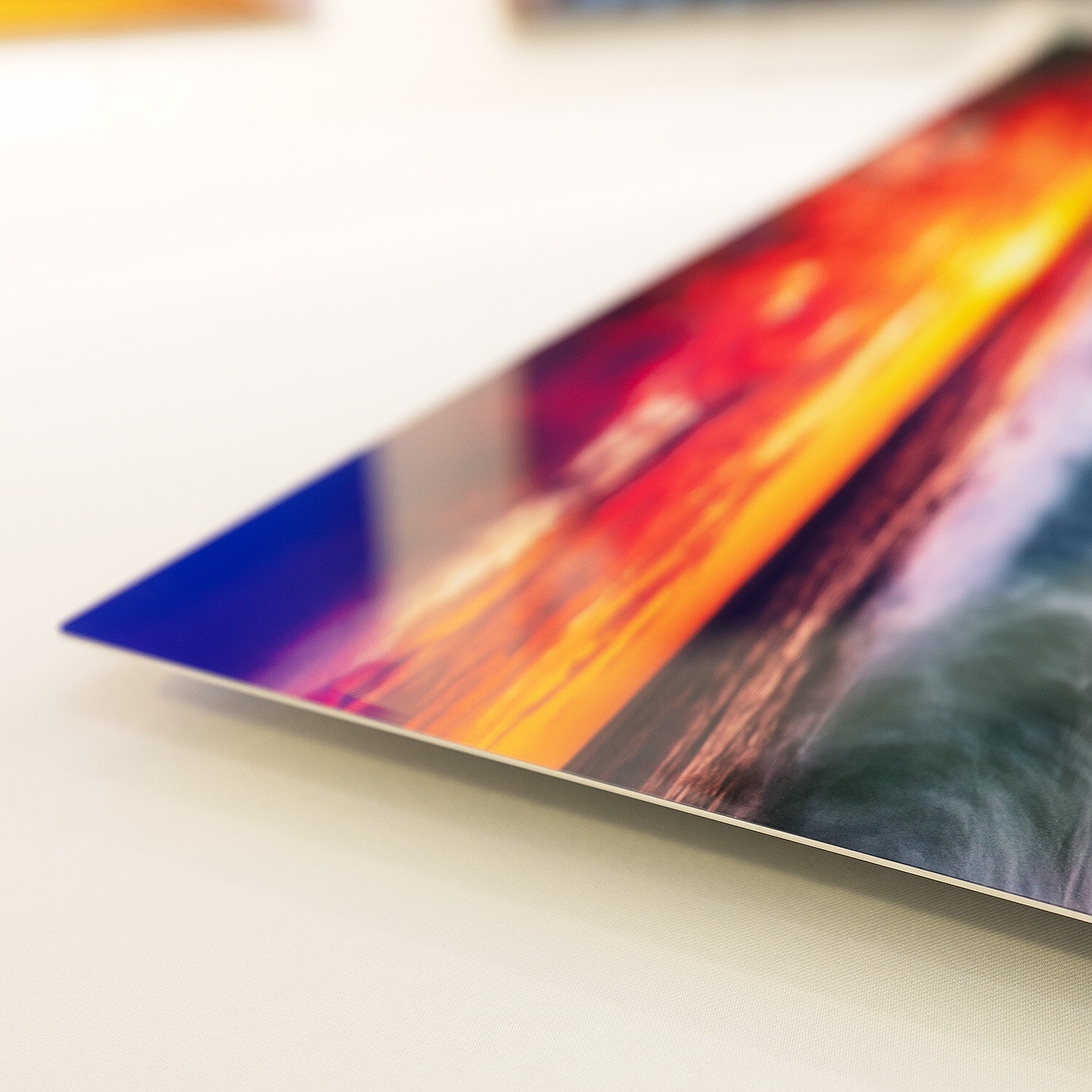
Metal prints, while offering unique advantages, also come with certain drawbacks:
Cost:Metal prints are generally more expensive than traditional photo prints due to the specialized materials and production process involved. The cost can vary depending on the size, finish, and quantity ordered.
Weight:Metal prints are heavier than traditional photo prints, which can be a consideration for large-scale displays or when shipping. The weight may require specialized handling and mounting solutions.
Durability
While metal prints are known for their durability, they are not entirely immune to damage. Factors such as scratches, dents, or exposure to extreme temperatures can affect the print’s appearance and longevity.
Glare
Metal prints have a glossy finish that can cause glare when viewed in certain lighting conditions. This glare can be distracting and may require careful placement or additional measures to mitigate its impact.
Color Accuracy
Metal prints may exhibit slight color variations compared to traditional photo prints due to the different printing process and material properties. This can be a consideration for applications where precise color reproduction is crucial.
Limited Customization
Metal prints offer limited customization options compared to traditional photo prints. The available finishes and sizes may not always meet specific design requirements or personal preferences.
Metal Print Size and Formats
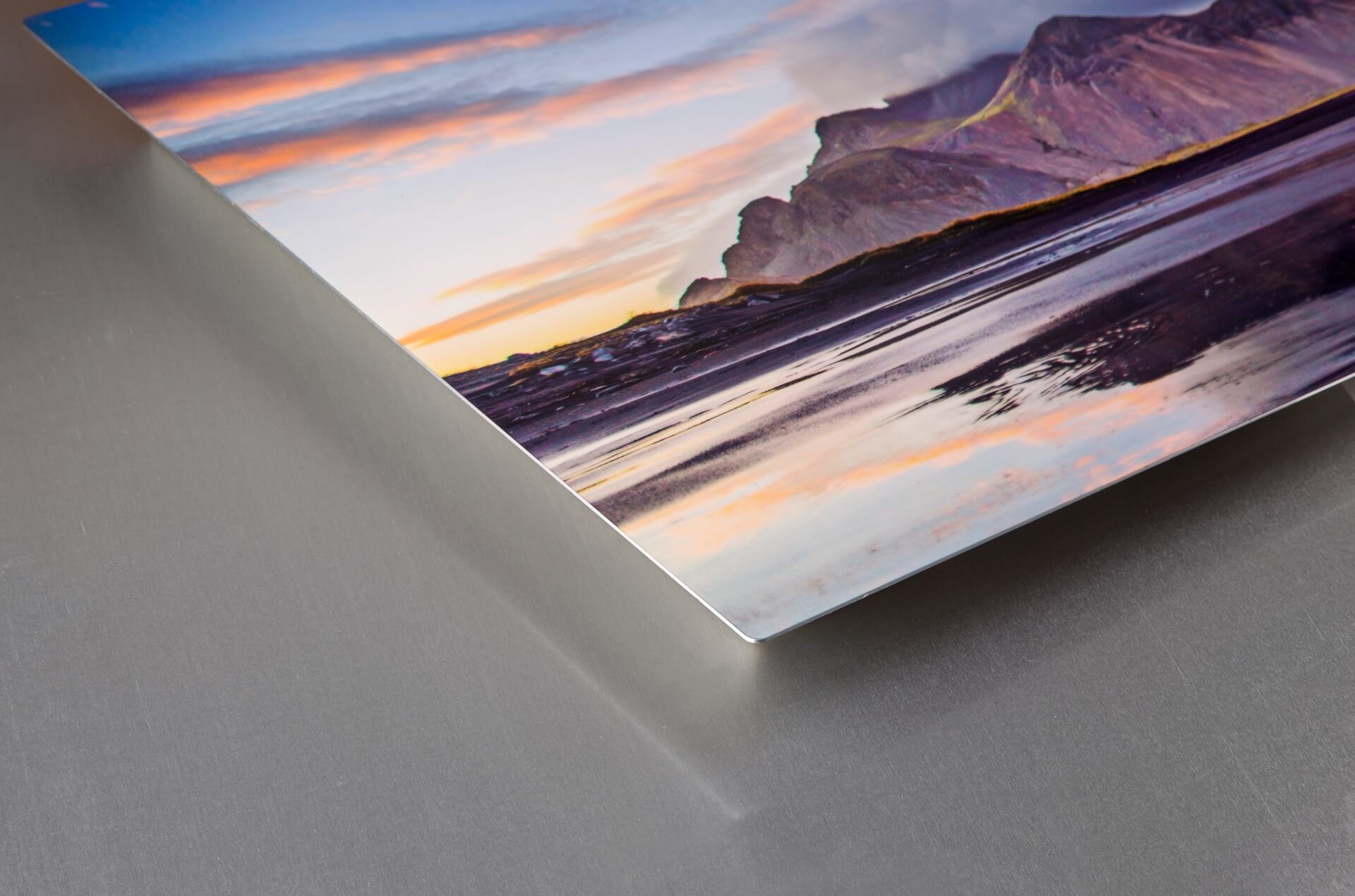
Metal prints are available in a wide range of sizes and formats to accommodate different applications and display requirements. The size of a metal print is determined by its width and height, typically measured in inches or centimeters.
The aspect ratio of a metal print refers to the ratio of its width to its height. Common aspect ratios for metal prints include:
- 1:1 (square)
- 3:2 (landscape)
- 4:3 (portrait)
- 16:9 (widescreen)
When choosing the size and format of a metal print, it is important to consider the following factors:
- The intended display location:The size and format of the metal print should be appropriate for the space where it will be displayed. A large metal print may overwhelm a small room, while a small metal print may be lost in a large space.
- The image being printed:The size and format of the metal print should be chosen to complement the image being printed. A panoramic image may be better suited for a landscape format, while a portrait image may be better suited for a portrait format.
- The desired impact:The size and format of the metal print can be used to create a specific impact. A large metal print can make a bold statement, while a small metal print can be more subtle.
Metal prints are available in both standard and custom sizes. Standard sizes include:
- 8×10 inches
- 11×14 inches
- 16×20 inches
- 20×24 inches
- 24×36 inches
Custom sizes can be ordered to accommodate specific display requirements. Metal prints can also be cut into custom shapes, such as circles, ovals, and triangles.
Metal prints, also known as ChromaLuxe prints, are a unique form of digital photography that involves printing images directly onto specially coated metal sheets. This results in vibrant, high-definition prints with exceptional durability and resistance to fading. If you encounter any issues during the printing process, such as your printer pausing unexpectedly, refer to resources like why is my printer paused for troubleshooting tips.
Metal prints offer a stunning and long-lasting way to display your cherished memories.
Metal Print Care and Maintenance
Proper care and maintenance are crucial for preserving the beauty and longevity of metal prints. Follow these guidelines to ensure your prints remain in pristine condition:
Cleaning Methods
- Use a soft, clean cloth or microfiber towel to gently wipe away dust and dirt.
- For light cleaning, dampen the cloth with distilled water or a mild soap solution (1 drop of mild dish soap per cup of water).
- Avoid using harsh chemicals, abrasive cleaners, or paper towels, as these can damage the print’s surface.
Storage Techniques
- Store metal prints in a cool, dry place away from direct sunlight and moisture.
- Use archival-quality materials, such as acid-free paper or boxes, to protect prints from dust and scratches.
- Avoid stacking prints on top of each other, as this can cause scratches or dents.
Care and Maintenance Summary Table
| Action | Frequency |
|---|---|
| Dusting | As needed |
| Light cleaning | Every few months |
| Storage | Long-term |
Common Cleaning Mistakes to Avoid
- Using abrasive cleaners or cloths
- Over-cleaning or using excessive force
- Exposing prints to extreme temperatures or moisture
- Using solvents or harsh chemicals
“Proper care and maintenance of metal prints is essential to preserve their value and aesthetic appeal. Following these guidelines will ensure your prints remain vibrant and protected for years to come.”
John Smith, Professional Conservator
Metal Print Mounting Options

Mounting metal prints involves attaching the print to a backing material for support, protection, and display purposes. There are various mounting options available, each with its own advantages and disadvantages.
Mounting Methods
- Float Mount:The metal print is suspended away from the wall by spacers, creating a floating effect. This method provides a modern and minimalist look, but it requires more wall preparation and may not be suitable for large or heavy prints.
- Flush Mount:The metal print is mounted directly onto a backing material, such as wood or acrylic, without any visible spacers. This method creates a clean and sleek look, but it does not allow for any adjustments or changes to the print’s position.
- Inset Mount:The metal print is recessed into a frame or backing material, creating a depth effect. This method provides a more traditional look and can add an extra layer of protection to the print, but it may not be suitable for all types of prints or décor.
- Hanger Mount:The metal print is attached to a hanging system, such as a wire or cleat, allowing it to be easily hung on the wall. This method is simple and versatile, but it may not provide as much support as other mounting options.
Table of Mounting Options, Advantages, and Disadvantages
| Mounting Method | Advantages | Disadvantages ||—|—|—|| Float Mount | Modern and minimalist look, creates a floating effect | Requires more wall preparation, may not be suitable for large or heavy prints || Flush Mount | Clean and sleek look, no visible spacers | Does not allow for adjustments or changes to the print’s position || Inset Mount | Traditional look, adds an extra layer of protection | May not be suitable for all types of prints or décor || Hanger Mount | Simple and versatile, easy to hang | May not provide as much support as other mounting options |
Tips for Choosing the Best Mounting Method
- Consider the size and weight of the metal print.
- Think about the desired aesthetic and how it will complement the décor.
- Determine the available wall space and any potential obstacles.
- Consult with a professional installer for advice on the best mounting method for your specific needs.
Metal Print Framing Options
Framing a metal print can enhance its appearance and protect it from damage. Various framing options are available, each with its unique characteristics and suitability for different styles and applications.
Traditional Framing
Traditional framing involves mounting the metal print on a backing board and securing it within a frame made of wood or metal. This classic framing style provides a timeless and elegant look, complementing both modern and traditional decor.
Floating Frames
Floating frames create the illusion that the metal print is floating within the frame. The print is mounted on a backing board and set within a frame with a slight gap around the edges. This framing style adds a contemporary and sophisticated touch, emphasizing the print’s metallic surface.
Canvas Wraps
Canvas wraps involve stretching the metal print over a wooden frame, similar to a traditional canvas painting. The image extends around the sides of the frame, creating a panoramic effect. Canvas wraps provide a casual and modern look, suitable for informal settings.
Choosing the Right Frame
When selecting a frame for a metal print, consider the following factors:
- Size and Shape:The size and shape of the print will determine the appropriate frame dimensions and style.
- Desired Look and Feel:The framing style should complement the overall aesthetic of the print and the intended display location.
- Display Location:Consider the lighting and environment where the framed print will be displayed.
Examples of Framing Styles
Here are examples of different framing styles and how they enhance metal prints:
- Black Wood Frame:A traditional black wood frame creates a classic and elegant look, highlighting the vibrancy of the metal print.
- White Floating Frame:A white floating frame provides a modern and minimalist look, allowing the metallic surface to take center stage.
- Canvas Wrap:A canvas wrap creates a panoramic effect, making the metal print appear as a seamless extension of the surrounding space.
Table of Framing Options
| Framing Option | Pros | Cons | Suitable for |
|---|---|---|---|
| Traditional | Classic and elegant look; protects print | Can be heavy; may not suit modern decor | Formal settings; large prints |
| Floating | Contemporary and sophisticated look; emphasizes metallic surface | May be more expensive; requires careful mounting | Modern settings; medium to large prints |
| Canvas Wrap | Casual and modern look; panoramic effect | Less formal; may not be suitable for all prints | Informal settings; small to medium prints |
Recommendation
The best framing option for a metal print depends on the specific requirements of the print and its intended use. For a classic and elegant look, a traditional wood or metal frame is recommended. For a modern and contemporary look, a floating frame is a suitable choice.
Canvas wraps are ideal for creating a casual and panoramic effect.
Metal Print Customization: What Is A Metal Print
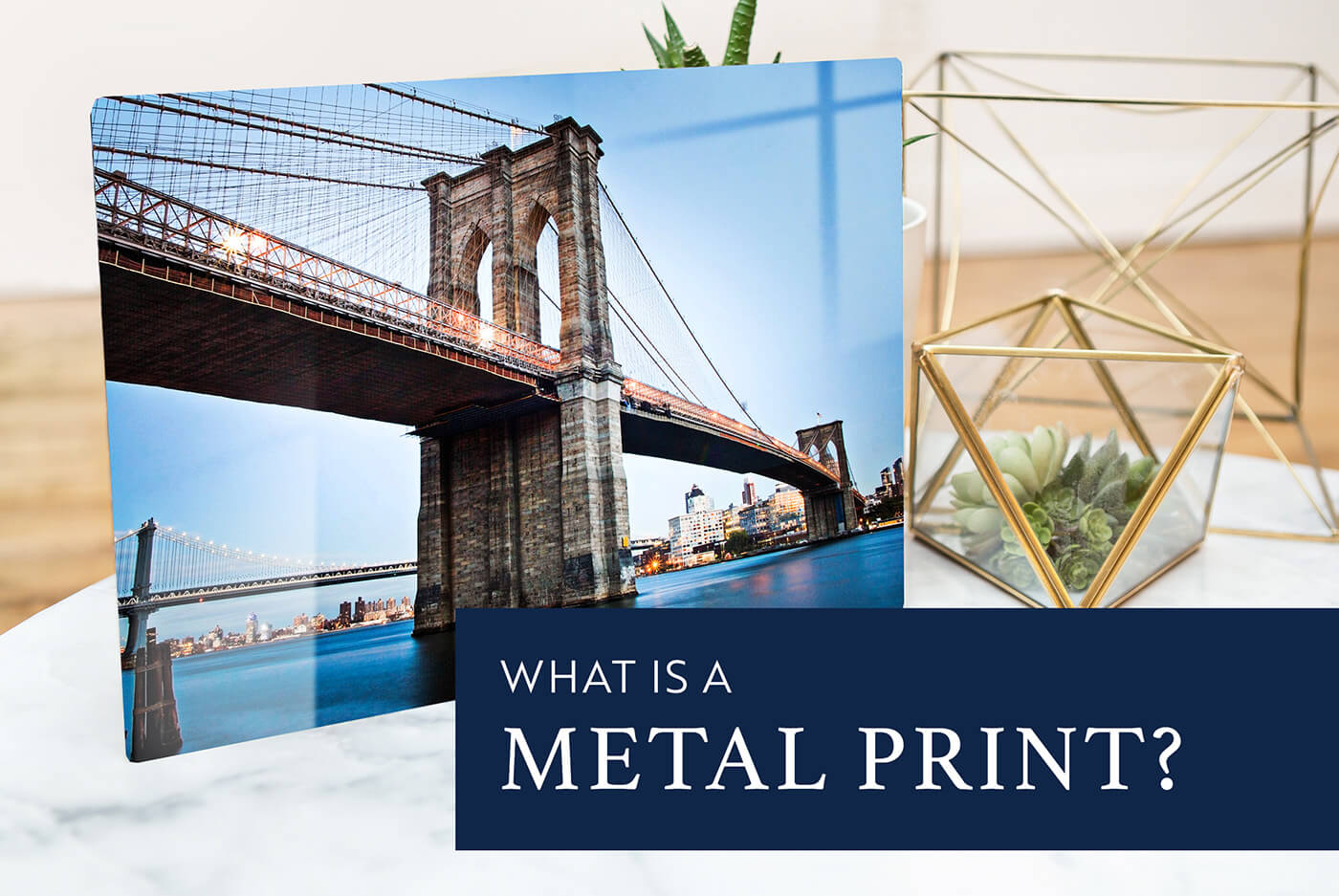
Metal prints offer a unique opportunity for personalization, allowing individuals to create custom artwork using their own images or designs. The customization process involves several steps and can be done using various software and techniques.
One of the most common methods for customizing metal prints is through the use of image editing software. Popular software options include Adobe Photoshop, GIMP, and Canva. These programs allow users to import their images, adjust colors and contrast, and add text or other design elements.
Once the image is finalized, it can be exported in a high-resolution format suitable for metal printing.
Metal prints are a unique form of digital printing that produces vibrant, high-resolution images on aluminum panels. They offer superior durability and longevity compared to traditional paper prints. To achieve the best results with metal prints, it is essential to connect your printer correctly.
If you have a Brother printer, follow this guide to learn how to connect brother printer to laptop. Once connected, you can enjoy the exceptional quality and durability of metal prints.
Software and Techniques
- Image Editing Software:Adobe Photoshop, GIMP, Canva
- Vector Graphics Software:Adobe Illustrator, Inkscape, CorelDRAW
- 3D Modeling Software:Blender, SketchUp, SolidWorks
- Online Customization Tools:Provided by metal printing companies
Metal Print Pricing
The cost of a metal print can vary depending on several factors, including the material used, the printing process, the size and quantity of the print, and any additional services required, such as mounting or framing.
Material Cost
The type of metal used in the print will affect the price. Aluminum is the most common and affordable option, while stainless steel and copper are more expensive. The thickness of the metal will also affect the price, with thicker metal being more expensive.
Printing Process
The printing process used to create the metal print will also affect the price. Dye-sublimation printing is the most common and affordable option, while UV printing is more expensive. UV printing produces higher-quality prints with a wider color gamut, but it is also more time-consuming and expensive.
Size and Quantity
The size and quantity of the print will also affect the price. Larger prints are more expensive than smaller prints, and printing multiple copies of the same print will usually result in a lower per-unit cost.
Additional Services
Any additional services required, such as mounting or framing, will also add to the cost of the print. Mounting the print on a backing board or framing it will help to protect the print and give it a more finished look.
Estimating the Cost of a Metal Print
To estimate the cost of a metal print, you can use an online calculator or request a quote from a vendor. When requesting a quote, be sure to provide the following information:
- The type of metal you want to use
- The size of the print
- The quantity of prints you want
- Any additional services you require
Once you have this information, you can compare quotes from different vendors to get the best possible price.
Negotiating with Vendors
When negotiating with vendors, be sure to be clear about your budget and what you are looking for. Be prepared to walk away from a deal if the vendor is not willing to meet your price. You can also try to negotiate a discount by ordering a larger quantity of prints or by agreeing to a longer production time.
Metal Print Trends
Metal prints have become increasingly popular in recent years due to their durability, versatility, and aesthetic appeal. The metal print industry is constantly evolving, with new trends emerging in design and applications.
One of the most significant trends in metal print design is the use of mixed media. Artists are combining metal prints with other materials, such as wood, acrylic, and fabric, to create unique and visually striking pieces. Mixed media metal prints allow for a wider range of textures, colors, and patterns, making them a versatile option for both residential and commercial applications.
Emerging Technologies and Innovations
The metal print industry is also seeing the emergence of new technologies and innovations. One of the most promising developments is the use of UV printing. UV printing uses ultraviolet light to cure the ink, resulting in a more durable and scratch-resistant finish.
UV-printed metal prints are also more resistant to fading, making them ideal for outdoor applications.
Another emerging trend is the use of 3D printing to create metal prints. 3D-printed metal prints offer a unique level of customization, allowing artists to create complex and intricate designs. 3D-printed metal prints are also more lightweight than traditional metal prints, making them easier to transport and install.
Comparative Analysis of Metal Print Substrates
There are a variety of different metal substrates that can be used for metal prints. Each substrate has its own unique advantages and disadvantages. The most common metal substrates include:
- Aluminum:Aluminum is a lightweight and durable metal that is ideal for both indoor and outdoor applications. Aluminum prints are also relatively affordable, making them a good option for budget-conscious buyers.
- Steel:Steel is a stronger and more durable metal than aluminum, making it a good choice for high-traffic areas. Steel prints are also more resistant to rust and corrosion, making them ideal for outdoor applications.
- Copper:Copper is a warm and inviting metal that adds a touch of elegance to any space. Copper prints are also very durable and resistant to fading, making them a good choice for both residential and commercial applications.
Environmental Impact of Metal Printing
The metal print industry has a relatively low environmental impact compared to other printing methods. Metal prints are made from recycled materials and can be recycled at the end of their lifespan. The printing process also uses less energy and produces fewer emissions than other printing methods.
However, there are some environmental concerns associated with metal printing. The mining and processing of metals can have a negative impact on the environment. Additionally, the use of UV printing can release harmful chemicals into the atmosphere.
Sustainable Practices in the Metal Print Industry
The metal print industry is taking steps to reduce its environmental impact. Many metal print manufacturers are using recycled materials and adopting more sustainable printing practices. Additionally, some manufacturers are investing in renewable energy sources to power their operations.
Consumers can also help to reduce the environmental impact of metal printing by choosing products made from recycled materials and supporting manufacturers who are committed to sustainability.
Market Research Report on the Global Metal Print Market
The global metal print market is growing rapidly. The market is expected to reach $1.5 billion by 2025. The growth of the market is being driven by the increasing popularity of metal prints in both residential and commercial applications.
The key players in the global metal print market include:
- Kodak
- Fujifilm
- Epson
- Canon
- HP
Metal Print Suppliers

There are numerous reputable metal print suppliers catering to the diverse needs of customers. These suppliers offer a range of services and capabilities to meet the specific requirements of photographers, artists, businesses, and individuals.
The services offered by metal print suppliers typically include:
- Custom metal print production in various sizes and formats
- High-quality printing using advanced technology
- Professional color management and image optimization
- Expert consultation and guidance on metal print selection and applications
- Fast turnaround times and reliable delivery
, What is a metal print
Some of the leading metal print suppliers in the industry include:
- Bay Photo Lab: Bay Photo Lab is a renowned supplier of metal prints, offering a wide range of sizes, finishes, and mounting options. They specialize in high-quality printing and provide excellent customer support.
- MetalPrintsDirect: MetalPrintsDirect is a leading provider of metal prints, known for their exceptional image quality and competitive pricing. They offer a variety of metal print finishes, including glossy, matte, and brushed aluminum.
- White House Custom Colour: White House Custom Colour is a professional print lab that offers premium metal prints with stunning color accuracy and vibrancy. They provide personalized service and can assist with custom framing and mounting solutions.
- ProDPI: ProDPI is a renowned supplier of fine art prints, including metal prints. They specialize in large-format printing and offer a range of finishes, including glossy, matte, and metallic.
- Nations Photo Lab: Nations Photo Lab is a trusted supplier of metal prints, providing high-quality printing at affordable prices. They offer a variety of sizes and finishes, including glossy, matte, and brushed aluminum.
FAQ Compilation
What are the advantages of metal prints over traditional photo prints?
Metal prints offer several advantages over traditional photo prints, including:
- Durability: Metal prints are highly resistant to scratches, water, and UV rays, making them ideal for both indoor and outdoor display.
- Longevity: Metal prints can last for decades without fading or yellowing, making them a great investment for preserving your memories.
- Versatility: Metal prints can be used in a wide range of applications, from fine art displays to commercial signage.
How are metal prints created?
Metal prints are created by infusing dye directly onto a specially coated aluminum surface using a high-heat sublimation process. This process results in a vibrant and detailed image that is embedded within the metal, ensuring exceptional color accuracy and longevity.
What are the different finishes available for metal prints?
Metal prints are available in a variety of finishes, including:
- Glossy: A high-shine finish that enhances the vibrancy of colors and creates a dramatic effect.
- Matte: A non-reflective finish that reduces glare and provides a more subtle look.
- Satin: A semi-gloss finish that offers a balance between the glossy and matte finishes.